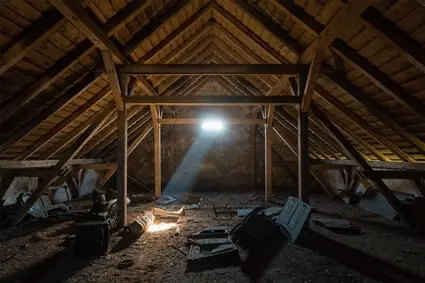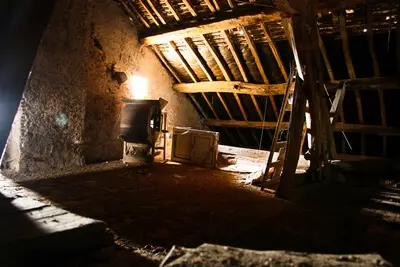During the summer months, attics can get very hot. Rats are tolerant of heat since they have ways of cooling themselves down.
However, they start to overheat once the temperature exceeds 90-100 degrees. That can leave you wondering if a hot attic can be a means of pest control.
Most rats can survive in a hot attic as homes don’t reach high enough temperatures to drive rats away.
Also, rats adapt by moving to a cooler area until the temperature decreases. They’ll drink more water, eat less food, lick themselves to cool off, and release excess body heat through their tails.
As soon as the temperature lowers, rats will return to their attic nest. If you don’t want rats to survive in the attic, you’ll need to trap them inside. Remove any water/food sources and plug any holes.
At What Temperatures do Wild Rats Die?
As mentioned, rats are resilient against high temperatures. However, they can get heatstroke and die when temperatures in their habitat exceed 90-100 degrees Fahrenheit.
When temperatures rise beyond the optimal range, they’ll experience dehydration and heatstroke. This causes organ failure and even death unless they find water sources to rehydrate and cool their bodies.
According to Animal Research Review, the optimal temperature range for roof rats is 65-80 degrees Fahrenheit (20-26 degrees Celsius).
If the temperature in their environment increases by 5-10 degrees, they’ll start to grow uncomfortable. Once the temperature reaches 90-100 degrees, the rat is at risk of heatstroke.

Do Rats Leave The Attic in the Summer?
In most regions, roof rats can live in the attic during the summer. The rising temperatures won’t automatically drive rats out. Rats are adaptable creatures and can survive in warm environments.
The attic is ideal during the winter, as it provides a warm environment to nest in. When the temperatures are warmer and balanced during the fall and spring, this will still be the case.
During the summer, rats may grow more uncomfortable due to spiking temperatures. However, the rats are likely to survive unless your home is in an arid region known for the extreme summer heat.
That’s partly because rats have several means of balancing out hot temperatures. Most of all, rats will be reluctant to leave their nest, so they’ll make do. Once rats build a nest, they become protective of it. They’ll always return to that nest and take great care in choosing its location.
It’ll be near food, water, safe shelter, and other necessities. Rats won’t leave unless forced out by a predator, major disturbance, or nest destruction. Even in a hot attic, it’s rare for temperatures to climb high enough for rats to consider the space uninhabitable.
However, on rare occasions, when the temperatures rise beyond what’s optimal, they’ll leave the attic to find a cooler living space. However, they may return once the season has changed.
Where Do Roof Rats Live During the Day?
Roof rats are primarily nocturnal animals, so they’re most active between dusk and dawn.
During the daytime, roof rats spend most of their time sleeping in their nests. These are usually located in attics, ceilings, and other spaces in the roofs of buildings.
How Can a Rat Live in a Hot Attic?
Rats can survive in a hot attic because they’re naturally acclimated to living in hot environments. This is possible because rats can do the following:
Control Their Body Temperatures
Rats don’t have sweat glands, so they use the blood vessels in their tails to release excess body heat.
The rat’s tail is well suited for thermoregulation for the following reasons:
- No fur to trap heat, unlike the rest of the body.
- Lots of blood vessels, especially near the tip.
- Rats’ tails are long with a large surface area.
Rats control their body temperature by constricting and dilating the blood vessels in their tails. When the temperature rises, a rat’s tail vasodilates (swells), thus allowing more blood to flow through it.
The warm blood loses heat through the surface of the tail and is pumped back to the body at a lower temperature—the warmer the rat, the more blood that’s passed into the tail.
When the temperature drops, the tail vasoconstricts (shrinks in diameter), limiting blood flow to the tail. This means less blood flows into the tail for cooling, maintaining the rat’s body temperature.
According to Physiology Behavior, rats apply saliva to their bodies to cool off. Also, they’ll rub saliva on their face, feet, and ears to lower their internal temperature, which has an evaporative cooling effect.
Willing To Leave During Extremes
There are times when temperatures in an attic get too extreme, beyond what rats can comfortably bear. At that point, rats may relocate to cooler areas.
This may include other parts of the house. However, some rats will retreat outdoors and build new nests in areas that aren’t as hot. For example, gardens, where there’s shade from trees, plants, and vegetation.
Find Cooler Places In The Attic
Rats will often burrow through insulation and enter plumbing and electrical conduit pipes. These places are cooler than the attic.
Visit Multiple Nests
Sometimes, rats have several nests that they move between, depending on the time.
When it’s hot outside, rats may retreat outside to enjoy the cooler environment in outdoor nests and return to the attic or other indoor nests at night to escape the cold.
Since rats are good swimmers, you may notice more rats in sewers and swamps during the summer.

Drink And Lay Down More, Eat Less
When rats get too hot, they’ll eat less and drink more to rehydrate and cool their bodies. It’s common for rats to sprawl out on cold surfaces to cool their bodies down.
What Happens If A Rat Gets Too Hot?
Rats are susceptible to overheating during extreme temperatures because they have fur coats that trap heat. Even with all their natural adaptations, there are times when rats get too hot.
When this happens, rats may experience heatstroke. That can lead to heart attacks, organ failure, and even death. Rats are more likely to get heat stroke during summer.
Signs of heatstroke in rats include:
- Lethargy
- Panting
- Eating less than usual
- Increased body temperature (hyperthermia)
- Vomiting and diarrhea
- Collapsing and laying down
- Minimal droppings and urine
- Drooling
Can Heat in the Attic Kill Rats?
Attics rarely get hot enough to kill rats, even during the summer.
However, rats require temperatures of between 65-80 degrees Fahrenheit. Anything above this will cause them discomfort. As the temperature increases, the risks to their health rise.
High attic temperatures high may be effective as a rodent control method. However, you must ensure that the temperature is 90-100 degrees Fahrenheit or higher.
Remove water sources in the attic, including any leaks, so rats can’t rehydrate.








